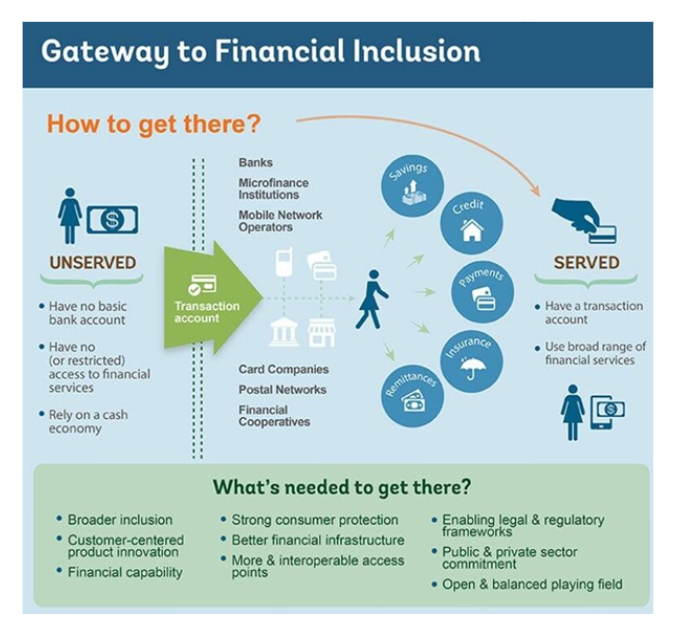Wednesday, 13th September 2023
Fraternity in India - Edukemy Current Affairs
In News: Fraternity does not mean anything if it glosses over social inequalities and then invokes social solidarity.
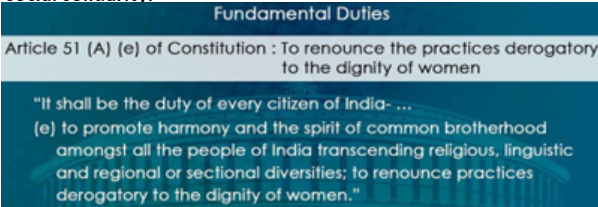
About the origins of ‘fraternity’
- In Plato’s Lysis, the philosopher invokes the word philia (love) for the strong desire to pursue wisdom.
- That is, love and friendship with others become more meaningful through the sharing of knowledge.
- The emphasis is on ‘share’ which gives us an early idea of the discourse of fraternity in ancient Greece.
- In Aristotle, we see the emergence of the polis, the logical location of a man who remains, first and foremost, a political being, and hence is part of the polis and not of the wild.
- Justice and friendship among citizens came to be the most enduring features of the polis.
- This here, is the birth of the idea of political fraternity.
- In the Middle Ages, fraternity flourished mostly through religion, within the churning of Christian society in Europe.
- The concept of fraternity then eventually found its entry into politics with the French Revolution of 1789 in the triptych of ‘liberté, égalité, fraternité’.
Why did India adopt fraternity?
- India’s independence struggle and the subsequent emergence of constitutional democracy saw the necessity of liberty, equality, and fraternity.
- In this context, Ambedkar’s stress on the inseparability of the three ideas and the underlining of fraternity cannot be emphasized enough.
- It was also necessitated by a complex Indian society at the precipice of becoming an independent republic, divided on the basis of various hierarchical social inequalities.
What is the status of fraternity in India today?
- Neglect of fraternity
- Fraternity happens to be the constitutional value that has received the maximum neglect both in the world of ideas and in the political field of action.
- The current nature of India’s fraternity is different from the political fraternity espoused in its Constitution.
- Lack of shared past
-
- In community ties, as M. C. Williams in The Idea of Fraternity in America (1973) explains, one sees an integral value system which is the foundation of the idea of fraternity.
- The privileging of the idea of community and the moral values associated with it, over the individual, gradually gave way to religious morality and its associated ‘way of life’.
- This elementary dimension of fraternity is missing when we assess fraternal ties in India.
- For, in order to have fraternal bonding between individuals, they must have an amicable shared past, not drawn from ideological differences rooted in the vast social inequalities among different communities.
- The shared history of India is marred by the caste system, and it militates against the principle of equality as well as the idea of liberty.
- But the Constitution privileges the individual, ensconced in the liberty, equality, and fraternity troika, leading to everyday conflict with the community.
- Therefore, the only conception of fraternity feasible for India must be rooted in politics. It is the only realm where caste privilege can be challenged.
- The ‘difference principle’
- John Rawls in his Theory of Justice (1971), stressed his ‘difference principle’. It works towards maintaining certain equality in order to realize political fraternity.
- The idea was and still is to create a level playing field between varying social groups, locked in structural hierarchies, to begin to understand what it takes to really actualize fraternal relations.
- In the absence of this crucial understanding, what we have is caste consciousness of unity, which remains aloof to members of other caste groups, and is often hateful to members of so-called lower caste groups in particular.
- India essentially then has fraternity within its caste communities, where forging political unity remains a forlorn goal.
What are the limits to fraternity?
- Glossing over social inequalities and then invoking social solidarity, turns fraternity futile.
- The call of such a fraternity is increasingly replaced with the rhetoric of belligerent nationalism which castigates a homegrown religious minority as its arch-enemy.
- Any sort of fundamentalism jettisons the possibility of fraternity.
- A fanatic can be anything but fraternal in the true sense.
In India, caste and the idea of political fraternity, given its social milieu, cannot coexist. One has to give way for the other to emerge.
Source: How fraternity in India is different from the idea enshrined in the Constitution - The Hindu.
Maritime trade route between India and Europe
Why in News: The India-Middle East-Europe Economic Corridor, announced at the G20 Summit, traces its historical roots to an ancient maritime trade route connecting the Indian subcontinent and the Europe.
Red Sea Route:
- It refers to an ancient maritime trade route that connected India with the Roman Empire through the Red Sea.
- This route facilitated the exchange of various goods, including luxuries like spices, ivory, pearls, gemstones, and pepper from India to the Roman Empire.
- The trade between Rome and India during antiquity was established by early excavations. Sir Mortimer Wheeler’s work at Arikamedu in the 1930s and 40s confirmed the existence of Indo-Roman trade in the 1st century CE.
- Ongoing archaeological excavations, such as those at Muziris in Kerala and Berenike in Egypt, continue to yield new evidence.
- Recent estimates, supported by the Muziris Papyrus, reveal the immense scale of the Red Sea trade. Custom taxes on goods from India, Persia, and Ethiopia possibly contributed up to one-third of the Roman exchequer’s income.
- The Muziris Papyrus detailed a cargo’s value, highlighting its enormous worth, with one cargo alone being equivalent to the purchase of premium farmland in Egypt or a prestigious estate in central Italy.
- The import tax collected on this cargo alone exceeded two million sesterces. Extrapolating from these figures, Indian imports into Egypt were likely worth over a billion sesterces annually, with tax authorities generating 270 million sesterces.
- The Romans had a great demand for Indian luxuries, including perfumes, ivory, pearls, gemstones, and exotic animals like elephants and tigers. Pepper, India’s major export, was particularly sought after, finding its way into Roman cuisine.
- The flow of goods from Rome to India was limited, with gold being a prominent export. Roman wine was one notable exception, appreciated by Indians.
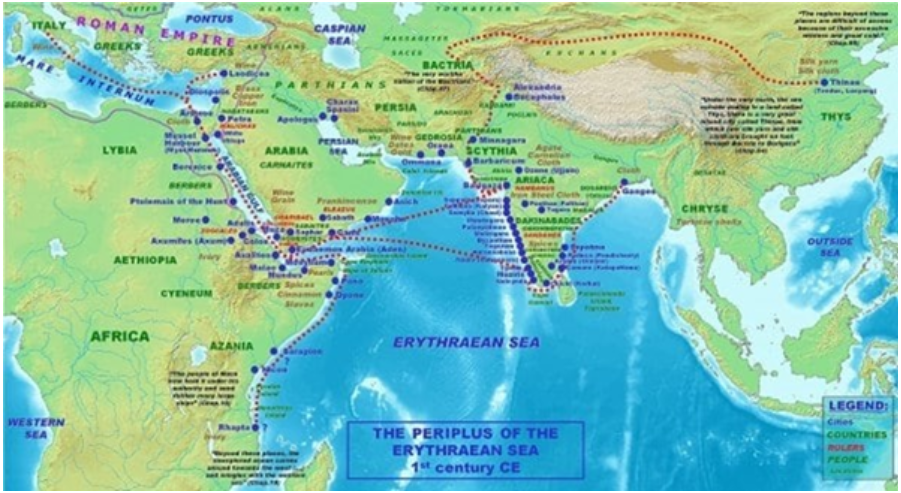
Pre-Common Era Trade:
- Evidence suggests the existence of an Indian diaspora in the Middle East during the time of the Indus Valley Civilization (c. 3300-1300 BCE). This early trade was coastal and involved smaller quantities of goods.
- The trade expanded significantly during Roman times, facilitated by large cargo ships directly connecting the subcontinent and the Roman Empire.
- The conquest of Egypt by the Romans in the 1st and 2nd centuries CE opened up the route to India, leading to a substantial increase in trade.
Organization and Duration of Journeys:
- Highly Organized Trade: Contracts were established between Indian merchants in Kerala and shippers in Alexandria. Goods were transported in containers, similar to modern practices, with references to insurance.
- Understanding Monsoons: Indians recognized the monsoon winds’ seasonal patterns, enabling them to navigate the route efficiently. The journey to Egypt took approximately six to eight weeks, depending on favourable wind conditions.
- Extended Stays: Indian diaspora rented houses in Egyptian ports while waiting for wind patterns to shift, allowing for the integration of Indian culture into these regions.
- Evidence suggests that Indian dynasties were interested in seafaring, as depicted in Ajanta paintings and early Indian coin designs featuring ships.
- Graffiti left by Indian sailors, primarily Gujaratis from Barigaza (modern-day Bharuch), has been discovered in the Hoq caves on the island of Socotra, emphasizing their active participation in the trade network.
Comparing with the Silk Road:
- Indian Centrality: The ancient economic and cultural hub of Asia, the Indian subcontinent, and its ports played a central role in maritime East-West exchange. The concept of the “Silk Road” is relatively recent and inaccurately portrays the ancient trade routes.
- Historical Invisibility: The Silk Road concept was coined in the late 19th century and did not exist in ancient or medieval times. It gained popularity in the 20th century, fostering romanticized ideas about East-West connectivity.
- Recent Politicization: Chinese President Xi Jinping’s Belt and Road Initiative has politicized the Silk Road, making it a central component of Chinese foreign policy.
India-Middle East-Europe Economic Corridor (IMEE-EC)
Why in News: Recently, on the side-lines of the G20 Summit in New Delhi, an MoU was signed between India, the US, Saudi Arabia, the European Union, the UAE, France, Germany, and Italy to establish the India-Middle East-Europe Economic Corridor (IMEE-EC).
India-Middle East-Europe Economic Corridor (IMEE-EC):
- It is an infrastructure development project that aims to create connectivity through rail and shipping networks, energy cables, and data links.
- It is part of the Partnership for Rail and Shipping Corridors Global Infrastructure Investment (PGII) and focuses on enhancing global trade and cooperation through critical infrastructure development.
- PGII is a collaborative effort by G7 nations to fund infrastructure projects in developing nations. It emphasizes loans over charity, benefiting both lending and receiving countries.
- It seeks to boost trade, clean energy, and economic growth while providing an alternative to China’s Belt and Road Initiative (BRI).
- Components of the Corridor:
- It will comprise two separate corridors, the Eastern Corridor, and the Northern Corridor. The former will connect India to the Arabian Gulf and the latter will connect the Arabian Gulf to Europe.
- It will include a rail link as well as an electricity cable, a hydrogen pipeline and a high-speed data cable.
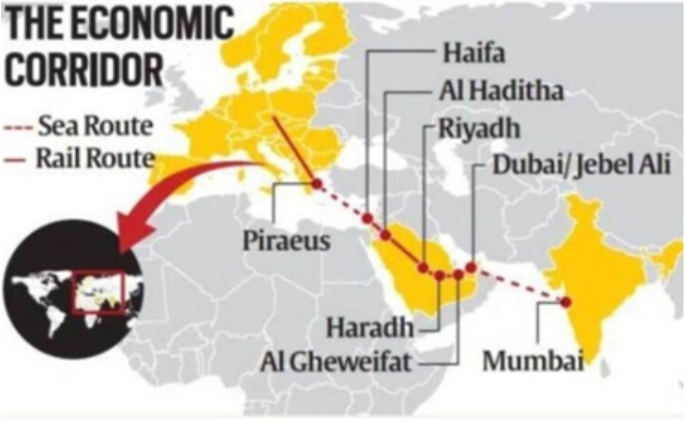
Significance of IMEE-EC Project:
- This would speed up trade between India and Europe by up to 40%.
- The plan is expected to be a possible game changer for global trade, presenting an alternative to China's wide-ranging strategic infrastructure investments.
- Enhancing food security, regional supply chains, trade accessibility, environmental considerations, economic cohesion, job creation, and reduces greenhouse gas emissions.
- It offers India a crucial role in global commerce, digital communication, and energy networks.
- It firmly positions India along the trade route spanning South East Asia to the Gulf, West Asia, and Europe.
Other Initiatives announced under PGII:
- Trans-African Corridor: It will connect the port of Lobito in Angola with Katanga province in Congo and the copper belt in Zambia.
- Clean Energy Projects in Indonesia: The PGII announced clean energy projects in Indonesia to support sustainable energy sources and infrastructure development.
- Investments in India’s Health Infrastructure: The US government’s International Development Finance Corporation (DFC) pledged over $15 million to invest in India’s health infrastructure, including eye clinics and women’s hygiene products.
- EU’s Global Gateway Program: The European Union (EU) committed to activating 300 billion USD in investments for critical connectivity projects, with a focus on Africa and various regions around the world.
Initiatives for promoting disability rights
In News: The Department of Empowerment of Persons with Disabilities (DEPwD) in India has embarked on a transformative journey.
About
The Department of Empowerment of Persons with Disabilities (DEPwD) in India is on a path of profound transformation. In its unwavering commitment to fostering a more inclusive society, DEPwD has established crucial collaborations and introduced pioneering programs to catalyze enduring societal change.
DEPwD's five initiatives encompass a range of groundbreaking actions:
- MOU with Council of Architecture: The department collaborates with the Council of Architecture (COA) to mandate universal accessibility courses in Bachelor of Architecture programs. This partnership extends to developing a certified course for architects and civil engineers to conduct accessibility audits in built environments, ensuring compliance with accessibility standards.
- Releasing of Anonymous Data of UDID: DEPwD's release of anonymous data through the UDID portal for research purposes facilitates data-driven decision-making in the disability sector, offering insights at various levels to enhance understanding and inform targeted interventions.
- PM Daksh Portal: PM Daksh Portal is a comprehensive digital platform for Persons with Disabilities seeking training and employment opportunities, offering seamless registration, skill training options, job listings, and streamlined administrative processes.
- Pathways to Access: Courts on Disability Rights: Judgments from India's Supreme Court and High Courts on disability rights have been compiled into a booklet, providing a reference guide for persons with disabilities and stakeholders in the disability sector.
- Online Case Monitoring Portal by CCPD: The Chief Commissioner for Persons with Disabilities adopts a cutting-edge application for handling grievances filed by persons with disabilities, making the entire process paperless and efficient, featuring seamless online complaint filing, automated reminders, and simplified hearing scheduling.
DEPwD's Vision of Inclusivity: Transforming Lives with Innovative Initiatives.
Genetic engineering to control Mosquitoes
In News: Genetic engineering gives mosquito control an upgrade.
About
- Innovations in genome sequencing technology have granted researchers unprecedented access to mosquito genomes, with a particular focus on Anopheles stephensi, a significant vector in the transmission of malaria.
- Genetic manipulation techniques, such as gene-drive technology, are being utilized to manage mosquito populations by disrupting their reproductive processes.
- Gene-drive technology alters mosquito DNA to reduce their reproductive capabilities or make them sterile, preventing the transmission of diseases like malaria.
- Some technology involves enhancing genes in mosquitoes to produce antimicrobial substances, disrupting disease transmission.
- How technology works? Genetically modified mosquitoes, such as OX5034, have been released in certain areas to reduce mosquito populations, showing promising results in decreasing disease incidence.
- Potential risks of technology: Such as ecological disruptions and unintended consequences in the ecosystem.
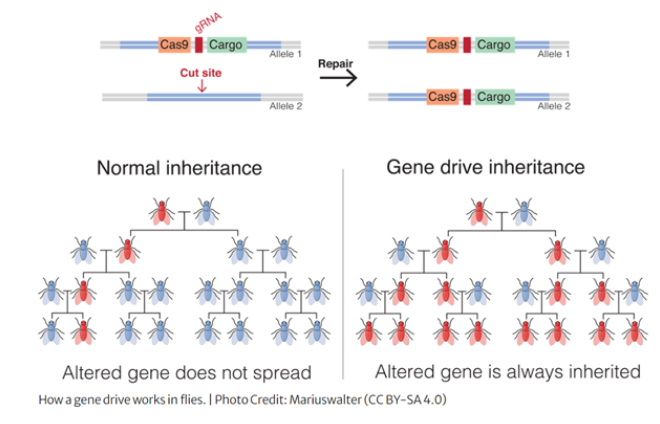 Buzzing breakthrough: genetic engineering gives mosquito control an upgrade - The Hindu
Buzzing breakthrough: genetic engineering gives mosquito control an upgrade - The Hindu
United Nations Global Stocktake Report
In News: Recently, United Nations released Global Stocktake report.
About
The Global Stocktake report from the United Nations serves as a guiding framework for deliberations during the Conference of Parties (COP), with its primary objective being the evaluation of countries' advancements in reducing greenhouse gas emissions since 2015.
Positive Findings:
- Impact of the Paris Agreement: The report underscores that the Paris Agreement has played a pivotal role in inspiring widespread climate action across the globe.
- Improved Temperature Projections: Notably, the report presents an improved outlook for global temperature rise, estimating it to be in the range of 2.4-2.6°C. This represents a significant improvement from the earlier, more alarming projection of 3.7-4.8°C in 2010.
Negative Findings:
- Excessive Emissions: Despite some progress, the report raises concerns about global emissions exceeding the limits established in the Paris Agreement. This underscores the urgency of further action.
- Ambitious Emission Reductions Needed: The report emphasizes the need for ambitious actions to achieve net-zero CO2 emissions. Specifically, an 84% reduction in global greenhouse gas emissions below 2019 levels by 2050 is deemed necessary.
- Deficits in Climate Action: The report identifies shortfalls in various aspects of climate action, including mitigation (reducing emissions), adaptation (adjusting to climate impacts), and finance. These deficits highlight the necessity for more comprehensive and robust efforts in addressing climate change.
Recommendations from the Report:
1. Mitigation: The report advocates for an inclusive and equitable transformation of energy systems, moving away from fossil fuels towards renewable energy sources such as solar and wind. This transition is seen as vital for mitigating greenhouse gas emissions.
2. Adaptation: To enhance resilience to climate change, the report suggests integrating climate change risks into all aspects of planning and implementation. It also emphasizes the importance of transparent reporting on adaptation efforts to track progress effectively.
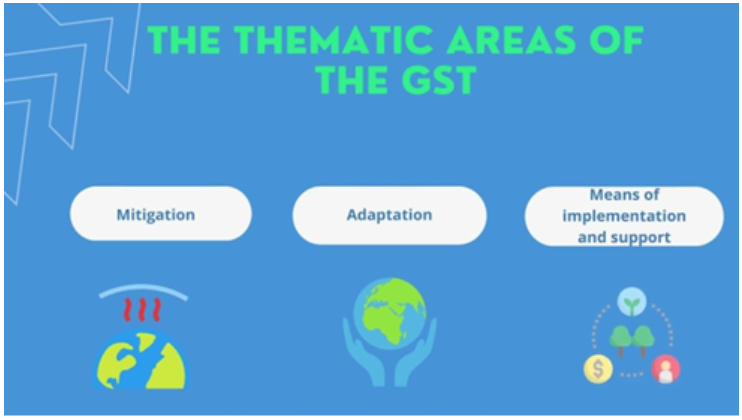
3. Climate Finance: Recognizing the financial challenges faced by developing countries, the report recommends improving access to climate finance. Ensuring that developing nations have adequate resources to combat climate change is essential for achieving global climate goals.
Stocktaking the calamity: The Hindu Editorial on climate crisis and the U.N. Global Stocktake report
Moodbidri - Edukemy Current Affairs
In News: Ancient terracotta figurines found during archaeological explorations at megalithic dolmen site near Moodbidri.
About archaeological Finding
- Recent archaeological excavations near Moodbidri in the Dakshina Kannada district have yielded a remarkable find related to the Megalithic Dolmen site.
- This discovery comprises a collection of unique terracotta figurines that offer valuable insights into the study of the Bhoota cult or Daiva Aradhane. These figurines have been determined to date back to the period of 800-700 B.C.
- The assortment of figurines discovered in this excavation includes depictions of various subjects, such as cow bovines, a mother goddess, peacocks, a horse, and more.
- These findings provide a fascinating glimpse into the cultural and religious practices of the ancient inhabitants of the region.
About Moodbidri
- Moodbidri, located in the Dakshina Kannada district of Karnataka, is a town and taluk situated 34 kilometers northeast of the district headquarters, Mangalore.
- The name "Moodbidri" is derived from the presence of abundant bamboo in the area during ancient times, reflecting its historical significance and the natural resources that once thrived there.
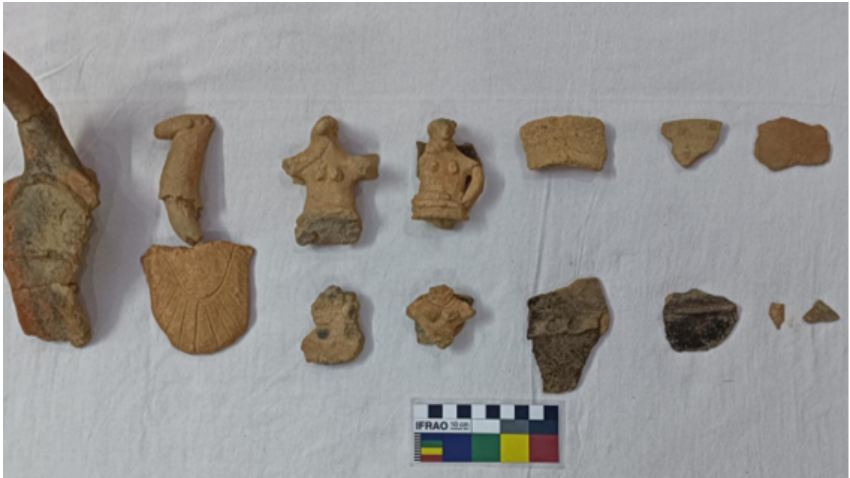
Project SamudraYaan - Edukemy Current Affairs
In News: Indian scientists are preparing for project Samudra Yaan to send three people 6,000 metres underwater beneath the ocean's surface in a domestically developed submersible called Matsya 6000.
About Mission Samudrayaan:
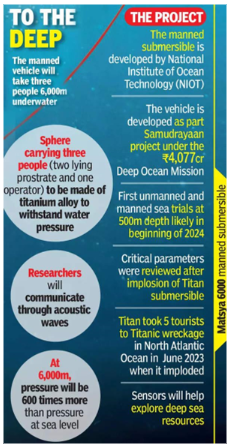
- The Samudrayaan mission is an integral part of the Deep Ocean Mission initiative, with sea trials planned at a depth of 500 meters slated for the first quarter of 2024.
- Only few countries, including the United States, Russia, Japan, France, and China, have successfully developed manned submersibles capable of exploring the depths of the ocean.
- Aim of Samudrayaan mission is primarily focused on exploring the ocean's depths in search of valuable metals and minerals, including cobalt, nickel, and manganese.
- It will also investigate the chemosynthetic biodiversity found in hydrothermal vents and low-temperature methane seeps in the ocean.
About Matsya 6000 Submarine:
- Matsya 6000 has been under development for nearly two years and is scheduled for its inaugural sea trials in the Bay of Bengal off the Chennai coast in early 2024.
- The submersible's design features a 2.1-meter diameter sphere constructed from an 80mm-thick titanium alloy, engineered to withstand the immense pressures at depths of 6,000 meters, which is approximately 600 times greater than sea level pressure.
- It has the capability to operate continuously for 12 to 16 hours, facilitated by a 96-hour oxygen supply.
Project Samudrayaan: Submersible Matsya to take a dip in Bay of Bengal next year
Vidya Samiksha Kendras - Edukemy Current Affairs
In News: Under the National Digital Education Architecture (NDEAR), the Ministry of Education is pushing States to open Vidya Samiksha Kendras (VSKs).
About
- Vidya Samiksha Kendra (VSKs) is a significant initiative aimed at creating a comprehensive data repository that will encompass information from all schemes administered by the Ministry of Education (MoE) in India.
- These centers will serve as control rooms to collect and manage data, enabling the tracking of key performance indicators and the analysis of data through the application of artificial intelligence (AI) and machine learning.
The repository will include regularly updated data from various educational programs and initiatives, including:
- PM-POSHAN Mid-day Meal Programs: Information related to the implementation and impact of the mid-day meal programs aimed at providing nutritious meals to schoolchildren.
- Teacher Training Data: Data regarding teacher training activities conducted through the National Initiative for School Heads' and Teachers' Holistic Advancement portal.
- Textbook Content: Content related to textbooks and educational materials available through the Digital Infrastructure for Knowledge Sharing.
- School Dropout and Attendance Data: Data on school attendance and dropout rates, managed under the Unified District Information System for Education (UDISE+).
- Students Learning Outcomes: Information on students' learning outcomes, typically assessed through initiatives like the National Achievement Survey.
- Performance Grading Index: This index evaluates the performance of the school education system at the state and union territory (U.T.) level.
Funding:
- The central government has allocated funds ranging from 2 to 5 crore rupees to each state for the adoption and establishment of Vidya Samiksha Kendras.
Significance:
- Mapping School Locations with Population: VSKs will facilitate the mapping of school locations with population distribution, allowing for the assessment of the Gross Access Ratio. This can help identify areas with a shortage of educational facilities and guide the establishment of new schools where needed.
- Planning for Industry Clusters: By analyzing data from VSKs, policymakers can gain insights into the skill requirements of specific regions or industry clusters. This information can be instrumental in tailoring educational and skill development programs to meet local demands.
- Higher Education Planning: VSKs can aid in the planning of higher educational institutions based on current and future educational needs and scenarios. This can lead to more strategic and efficient resource allocation in the higher education sector.
Education Ministry asks States to bring all data under one platform - The Hindu.
Indian Cultural Gifts to G-20 Leaders
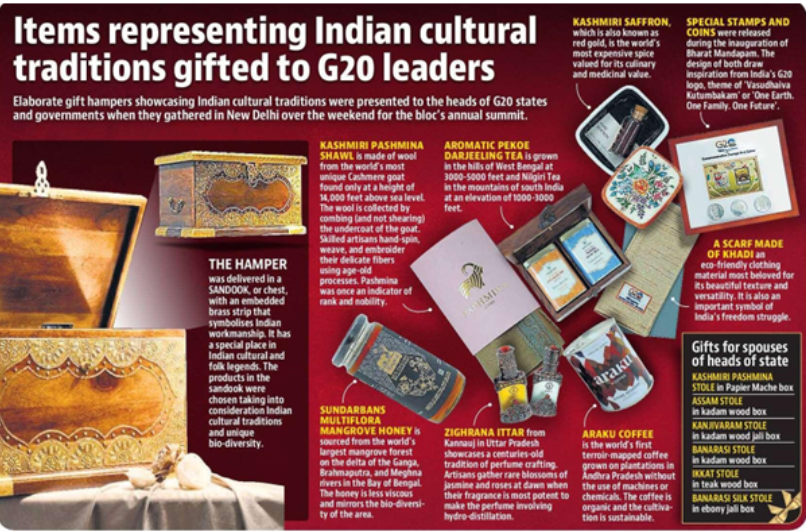
Climate Phenomenon and Food Security
Exam View: El Nino and El Nino Southern Oscillation; El Nino Phase and Climate Change; El Niño and food security; Response to Climate Change phenomenon
Context: There has been a series of disruptive weather and climate phenomena in India this year, demonstrating the complexity of our precipitation system. Western disturbance, which usually brings rain and moisture to the western Himalayas parts of northern India during winters, has remained active late into the summer.
About the El Nino and El Nino Southern Oscillation [ENSO]:
- El Niño is a climate pattern that describes the unusual warming of surface waters in the eastern tropical Pacific Ocean.
- In a normal year, a surface low pressure develops in the region of northern Australia and Indonesia and a high-pressure system over the coast of Peru. As a result, trade winds over the Pacific Ocean move strongly from east to west.
- The easterly flow of the trade winds carries warm surface waters westward, bringing convective storms to Indonesia and coastal Australia. Along the coast of Peru, cold bottom cold nutrient-rich water wells up to the surface to replace the warm water that is pulled to the west.
- In an El Niño year, air pressure drops over large areas of the central Pacific and along the coast of South America.
- There is a weak high in the western Pacific. This change in pressure pattern causes the trade winds to be reduced intensity and sometimes it might even get reversed.
- This reduction allows the equatorial counter-current to accumulate warm ocean water along the coastlines of Peru and Ecuador. This prevents upwelling of cold deep ocean water along the coast of Peru and brings drought to Indonesia and Australia along with rains in South America
- The formation of an El Niño is linked with the Pacific Ocean circulation pattern known as the southern oscillation. El Nino and Southern Oscillation coincide most of the time hence their combination is called ENSO – El Nino Southern Oscillation.
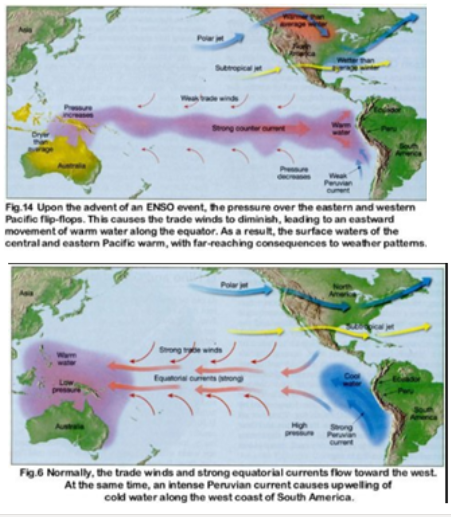
Impact of El Nino Phase on Climate:
- Droughts and water scarcity in South East Asia and Australia. It leads to water scarcity in many parts of India and adversely affects agriculture, causing a decrease in crop yields.
- Forest fires: During El Niño years, drier conditions may increase the likelihood of forest fires, especially in regions prone to such disasters.
- Climate extremes: El Niño can contribute to other climate extremes in India, such as heatwaves and intense cyclones.
- Climate induced disasters: Landslides and flooding in the western Himalaya and northern India leads to destruction of infrastructure and loss of life.
- Inter annual Variability in rainfall: 65% of the inter-annual variability of the southwest monsoon, over many decades, can be attributed to the combined effects of ENSO and the IOD.
Impact of El Niño on food security:
- Affects agricultural processes: El Nino and associated phenomenon affects rain fed agriculture by delaying the start of rains, affecting sowing, hot temperatures negatively influence plant growth and soil moisture.
- Unirrigated lands: More than 50% of agricultural land is unirrigated. Thus any delays in monsoon affects crop growth severely.
- Erratic Monsoons: Breaks in monsoon, delays in its advent and disproportionate rainfall in different regions affects growth of crops and hampers food security.
- Dependence on green water irrigated regions: Even in irrigated areas, many dominant crops require green water (Green water is rain-fed soil moisture tapped by food and cash crops, eventually transpiring into the atmosphere) to different extents. For example, in kharif season, rice paddy under irrigation uses green water to the tune of 35%.
- Growth of Rabi crops: Contributions of green water from northeast monsoon in southeast India and Western disturbance in north plays significant roles in determining the fate of Rabi crops.
Impact of El Nino on northeast monsoon:
- Central India’s highlands, encompassing 36 districts in the states of Madhya Pradesh, Chhattisgarh, and Maharashtra, which are emerging as climate change hotspots critical for our water, food and ecological security.
- NE Monsoon feeds headwaters for five of India’s 10 major river basins thus playing an important role in India’s water security.
Response to Climate Change phenomenon:
- Reducing dependence on water-intensive crops: With introduction of millets agriculture is shifting to less water-intensive crops which may reduce vulnerability of our food systems to phenomena like El Niño.
- Adaptations and alternative crop strategies like shifting to millets and alternative varieties of dominant cereals and advisories to farmers to switch to crops with shorter growing cycles.
- Alternative short-term and long-term management of our dams and reservoirs is required to reduce the risk of dam-based flood disasters and ecological damage to aquatic ecosystems.
Share the article
Edukemy’s Current Affairs Quiz is published with multiple choice questions for UPSC exams
MCQ
Get Latest Updates on Offers, Event dates, and free Mentorship sessions.

Get in touch with our Expert Academic Counsellors 👋
FAQs
UPSC Daily Current Affairs focuses on learning current events on a daily basis. An aspirant needs to study regular and updated information about current events, news, and relevant topics that are important for UPSC aspirants. It covers national and international affairs, government policies, socio-economic issues, science and technology advancements, and more.
UPSC Daily Current Affairs provides aspirants with a concise and comprehensive overview of the latest happenings and developments across various fields. It helps aspirants stay updated with current affairs and provides them with valuable insights and analysis, which are essential for answering questions in the UPSC examinations. It enhances their knowledge, analytical skills, and ability to connect current affairs with the UPSC syllabus.
UPSC Daily Current Affairs covers a wide range of topics, including politics, economics, science and technology, environment, social issues, governance, international relations, and more. It offers news summaries, in-depth analyses, editorials, opinion pieces, and relevant study materials. It also provides practice questions and quizzes to help aspirants test their understanding of current affairs.
Edukemy's UPSC Daily Current Affairs can be accessed through:
- UPSC Daily Current Affairs can be accessed through Current Affairs tab at the top of the Main Page of Edukemy.
- Edukemy Mobile app: The Daily Current Affairs can also be access through Edukemy Mobile App.
- Social media: Follow Edukemy’s official social media accounts or pages that provide UPSC Daily Current Affairs updates, including Facebook, Twitter, or Telegram channels.


